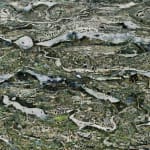-
Artworks








Sohei Nishino
Mountain Line, Everest , 2019Archival pigment print on Hahnemuhle Photo-Rag Baryta paperSMALL
image/Paper size 185 cm x 105.4 cm
Framed size: 120 x 200 cm
Edition of 15 + 2 APs
£25,000 Excl. tax, framing and shipping
LARGE
Image/Paper size: 263 x 150 cm
Framed size: 268 x 155 cm
Edition of 5 + 2 APs
£50,000 Excl. tax, framing and shippingAccompanied by a signed label from the artistFurther images
-
(View a larger image of thumbnail 1
)

-
(View a larger image of thumbnail 2
)

-
(View a larger image of thumbnail 3
)

-
(View a larger image of thumbnail 4
)

-
(View a larger image of thumbnail 5
)

-
(View a larger image of thumbnail 6
)

-
(View a larger image of thumbnail 7
)

-
(View a larger image of thumbnail 8
)

Literature
About this print:
Sohei Nishino’s enduring fascination with map-making has taken a new direction in his most recent projects, which bring his cartographic vision to bear upon places which have traditionally defied definition on paper. His signature photo-collage technique pieces together thousands of images taken over the course of his travels, to construct dioramas of complex geographies which integrate human and physical landscapes.
Nishino’s Everest draws inspiration from the maps used traditionally by pilgrims to navigate holy sites. Fascinated by the historical significance and symbolism of Everest, Nishino shot almost 400 rolls of film during his 23 day journey from Lucla to Gokyo Peak. He relates this intense journey through the Himalayas to those undertaken by sherpas and other local people who call the mountain home. Instead of following a linear course to a fixed destination, Nishino captures his experience of the road from a dense and meticulously planned variety of vantage points. Whilst Nishino continues to explore his interest in the relationship between people and their environment, his map of Everest illustrates an intense engagement with this harsh geography, and the ways that it shapes the lives of local populations. Nishino has described this project as one of the toughest periods of shooting, and in its unprecedented scale and use of colour it stands apart from his other work to date.
Biography:
In making his diorama maps, Nishino combines photography, collage, cartography and psychogeography to create large prints of diverse places. Drawing inspiration from the 18th century Japanese mapmaker Ino Tadataka, his prints re-imagine the locations he has visited. To build his diorama maps, Nishino walks for an average of three months, exploring many vantage points and gathering hundreds of rolls of exposed film. He then painstakingly prints the photographs by hand and compiles them to form the tableaux he will use as the basis for his limited edition photographs.
The overall effect is not a traditional bird's-eye view but an enlightened way of seeing three dimensions in a single plane. Although geographical accuracy is important in this process, scales are altered and locations occasionally repeated, mimicking our own fluid memories of place and time. From a distance the maps are almost abstract, it is not until we examine them in detail that the full diorama unfolds - the theatre of one man's city played out in miniature.
Sohei Nishino was born in Hyogo, Japan in 1982. He graduated from Osaka University of the Arts in 2004, when he began working on his diorama Map series. Since then he has exhibited his work internationally and gleaned numerous awards including the President Award, Osaka University of Arts (2004), the Young Eye Japanese Photographer Association Award (2005), the Canon New Cosmos Photography Award (2005) and the Canon Excellence Award (2005). He has also participated in several group shows, festivals and solo exhibitions: Daegu Photo Biennale, Korea (2010); Out of Focus exhibition, Saatchi Gallery, London (2012); Contemporary Japanese Photography vol.10, Tokyo Metropolitan Museum of Photography (2012); A Different Kind of Order: ICP Triennial, New York (2013).
1of 18 -
(View a larger image of thumbnail 1
)







